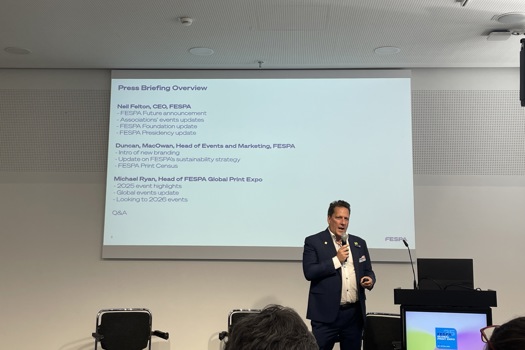The story of the Ryobi 3300 series starts back in the mid-1980s, when the 3302 was released. This two-colour press was tweaked and modified until 1996, when the four-colour 3304H burst on to the scene. The 3304H came with continuous dampening, so it could maintain a stable aqua film on the plate. The dampener volume was controlled to match the ink, plate, paper and press conditions with a motor-driven fountain roller.
In 1998, Ryobi then went a step further, introducing the HA version of the press. The A on the machine stands for semi-automatic plate change. The minder positions the plate on the positioning pins, presses a button and the press does the rest. There's also no need to bend the plate's leading or tall edge.
It resulted in some "stunning" results, according to Neil Handforth, sales and marketing director at Apex Digital Graphics, the distributor for Ryobi presses in the UK. The product was the first four-colour option in SRA3-sized portrait format.
"It uses a five-cylinder principle, with double-diameter impression cylinders. This meant there were just four gripper changes needed," says Handforth.
Standard shape
The 3304 features a universal paper feed, 16-roller inker, six water rollers and a centralised oiling system. It uses Ryobi's well-known ‘V' shape configuration for its impression cylinders, printing units and double-diameter transfer drums. The result is fewer gripper changes between the first and final printing unit. It also means the machine has a compact footprint of 3.7x1m.
The machine far exceeded the expectations of its manufacturer. As an SRA3 four-colour machine, its target market was the production of short-run, low-cost, basic colour work, such as leaflets, flyers, envelopes and postcards.
"However, customers are stretching the machine's abilities to produce quality reproductions, such as small posters. These applications are really intended for a B3 landscape press," says Handforth.
Software updates
Improvements have been made on the machine to keep it up-to-date with current technology, but these were mainly software upgrades, rather than hardware modifications.
"We also standardised the off-press controls, but the machine is essentially still the same," says Handforth.
The 3304 has remote control ink ducts, ink temperature control, automatic dampening presetting, automatic blanket and cylinder wash-up. While optional extras included ink volume pre-setting.
"As with all used presses, check the cylinders for any damage, the roller condition and the ink ducts for consistent delivery," advises Handforth.
He adds that "hundreds" have been sold in the UK and "thousands" worldwide. While the H model of the 3304 is no longer in production, the 3304HA is still sold new. Both new and used presses can be sourced from Apex directly. The dealer also takes in good-quality machines as part-exchange.
Apex stores spare parts at its headquarters in Hemel Hempstead and a new machine costs between £125,000 and £130,000 depending on whether it's been fitted with inks volume setting (IVS) software.
A used machine costs £40,000-£50,000, depending on age and condition. At the time of writing, four models from 1999 to 2003 were advertised on used machinery site PressXchange.
SPECIFICATIONS:
Max units four
Speed 10,000sph
Max paper size 340x450mm
Min paper size 90x100mm
Paper thickness 0.04- 0.3mm
Plate size 335x485mm
Footprint 3.75x1.04m
Weight 3 tonnes
Price
New 3304HA £125,000-£130,000
Used 3304 HA £40,000-£50,000 DOC
What to look for
- Cylinders
- Ink ducts
- Roller condition









